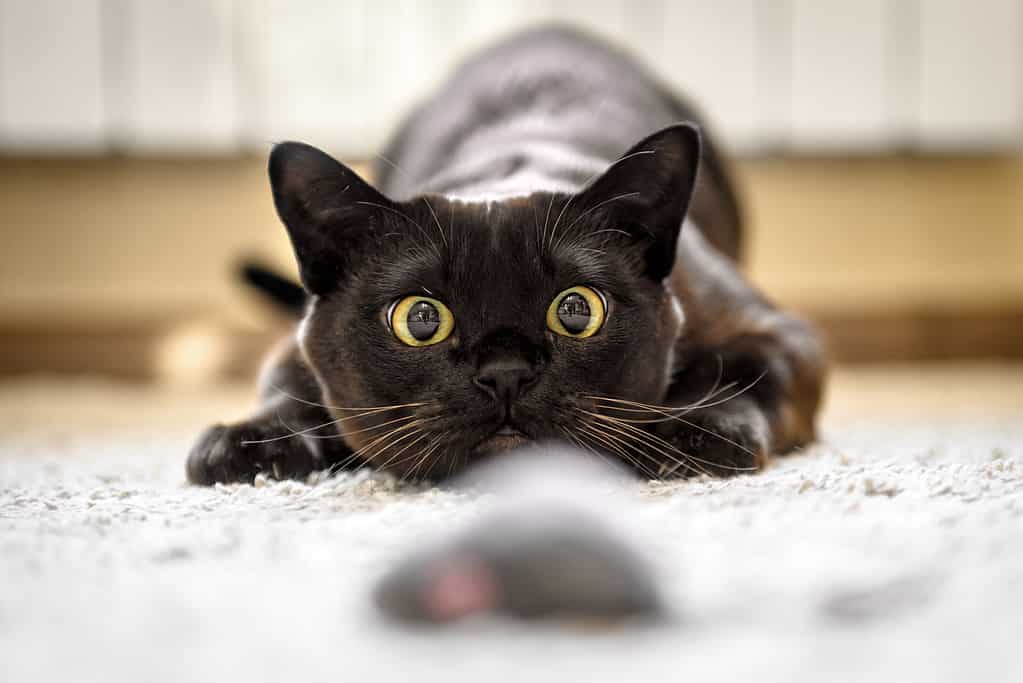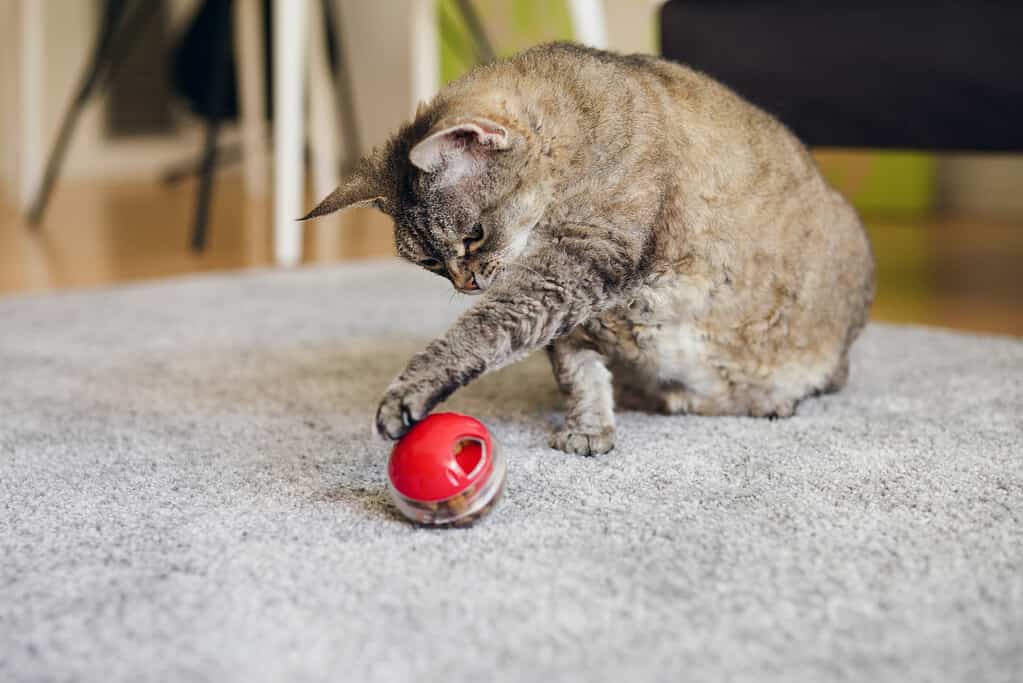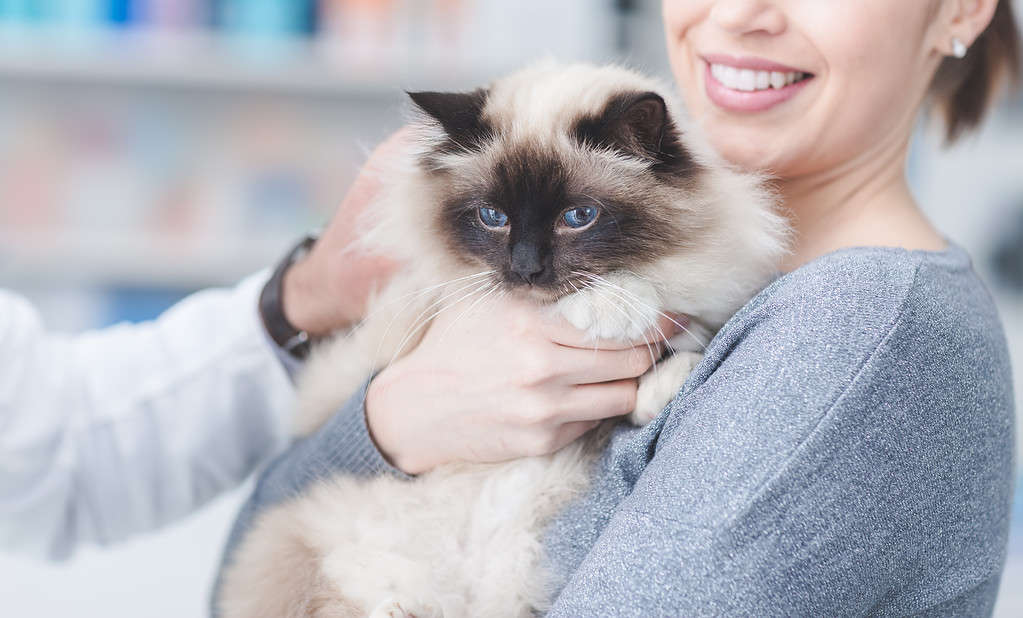Contrary to some misconceptions, cats can experience separation anxiety. While it isn’t quite as common as it is with dogs, cats with this condition will display similar signs of distress when they are left alone for extended periods.
In fact, it’s not that uncommon. Many cats form strong bonds with their owners and may feel stressed when separated. Cat breeds that tend to be very people-oriented are more likely to develop this condition.
Signs may include things like excessive meowing, changes in appetite, destructive behavior, and litter box problems. All of these are signs of stress in general, though. If your cat displays any of these, it’s important to figure out why they are anxious and address the underlying issue, if possible.
How Common is Separation Anxiety in Cats

Burmese cats are one of the breeds prone to separation anxiety. However, having toys available can help substantially.
©scaliger/iStock via Getty Images
We don’t exactly know how many cats have separation anxiety. Unlike separation anxiety in dogs, this disorder is poorly researched and understood in cats. As many as 15% of cats may have separation anxiety, but we are just now starting to understand the signs associated with it.
Separation anxiety in cats seems to be related to the number of females living in the residence, a lack of toys, and no other animals residing in the house. If your cat has no toys and is an only pet, they may be more likely to develop separation anxiety.
The severity of separation anxiety can vary, too. Some cats may only experience occasional anxiety and only display one or two signs. Others may have severe anxiety, making it much more obvious that something is wrong. Many cats go undiagnosed, so there is reason to believe that separation anxiety may be more common in cats than currently reported.
Individual cats can vary greatly in their susceptibility to separation anxiety and the symptoms they display when they develop it. A cat’s temperament, history, and living situation all affect the likelihood that they will develop separation anxiety.
Signs of Separation Anxiety in Cats

Aggression is a less common sign of separation anxiety.
©Oleg Troino/Shutterstock.com
There are many signs of separation anxiety in cats. Some of these are more common than others. While cats display symptoms similar to dogs, there are some obvious differences.
According to one study, destructive behavior was the most common behavioral criteria used to diagnose separation anxiety. As many as 66% of cats with separation anxiety will display destructive behaviors.
Of course, there are other symptoms, too. Here are the most common ones, along with the percentage of cats displaying this symptom:
- Excessive vocalization (63%)
- Inappropriate urination (60%)
- Depression (53%)
- Aggressiveness (36%)
- Agitation (36%)
If your cat has one or more of these symptoms, they could have separation anxiety. However, these symptoms are also caused by other conditions. Therefore, it’s important to make an appointment with your vet to ensure your cat is physically healthy before assuming they have separation anxiety.
How to Prevent Separation Anxiety

Cat toys can help keep your feline entertained and engaged while you’re away, preventing anxiety.
©insonnia/iStock via Getty Images
You cannot always prevent separation anxiety. In some cases, your cat may develop separation anxiety despite your every attempt to prevent it. Some felines are just prone to this condition.
However, there are a lot of things you can do to prevent it.
One preventative strategy is to make their environment as stimulating as possible. Scratching surfaces and various toys give your feline something to do while you’re gone and can be a distraction. You should rotate toys to maintain their interest. For very intelligent cats, consider puzzle feeders, which can be more challenging than your average toy.
Cats love to climb and perch, too. Set up cat trees, shelves, and window perches to keep the space interesting.
Cats are creatures of habit. Therefore, they often feel less stressed with a consistent schedule. Maintain set playing and feeding times as much as possible so your cat can predict what will happen throughout the day. Having set times when you are away can also be helpful.
If your cat has a general idea of how long you’ll be gone, they may feel less stressed about being alone.
Some cats find catnip calming. If your feline falls into this category, you can use catnip to help keep them entertained and stress-free while you’re gone. Catnip toys are a great option, especially for more active cats.
How to Treat Separation Anxiety in Cats

If you believe your cat has separation anxiety, make an appointment with your vet to ensure they’re physically healthy.
©cyano66/iStock via Getty Images
Preferably, you should prevent separation anxiety in cats if at all possible. Using the options above, like creating a stimulating environment and establishing a routine, can all help prevent separation anxiety.
If separation anxiety has already developed, they can also help treat it. However, they may not be as effective or work on their own. You may need to use other treatment options, too.
It’s crucial to seek out professional guidance from a veterinarian when diagnosing and treating separation anxiety. Lots of other health problems can also resemble separation anxiety. Cats are often very good at hiding their illnesses, so you may not even know they’re sick. Small behavioral changes may be the only symptoms you notice.
Therefore, it’s important to ensure that your cat is actually experiencing separation anxiety and not a different illness.
There are several ways to treat separation anxiety directly. One of these is through positive reinforcement training. This training involves using treats and praise to slowly get your cat comfortable with your absence. When you leave, you can use a remote treat system or a friend to reward your cat for calm behaviors.
You should avoid rewarding your cat when you come back. This may only make your cat more anxious for you to return, which is the opposite of what we aim for.
You can also use desensitization and counterconditing techniques. Many cats develop anxiety around “leaving signals,” such as when you grab your keys or put on your shoes. The idea is to do these at all times of the day, not just when you’re leaving. Over time, your cat will stop associating these behaviors with anxiety.
Sometimes, medication may be necessary while training and desensitizing your feline. Your vet can help you determine if your feline falls into this category.
Treating separation anxiety takes time and effort. It’s important to be patient no matter your treatment strategy.
Cat Breeds Prone to Separation Anxiety
Any cat breed can get separation anxiety. However, certain cat breeds are more prone due to their social nature and desire for interaction. Here are some of the most common ones:
- Siamese: These felines are known for their vocal personalities and strong bonds with people. Therefore, they may become distressed when left alone for an extended period.
- Burmese: This breed also becomes very attached to people, craving constant attention. These traits can turn into separation anxiety in many cats, resulting in destructive behaviors and excessive meowing.
- Oriental Shorthair: Similar to the cat breeds we’ve discussed thus far, this breed is also affectionate and people-oriented. They may be prone to separation anxiety when left for long periods without companionship.
- Sphynx: These hairless felines are also very loving and require considerable amounts of attention. If they don’t get it, they may develop anxiety when separated from their people.
Breed is one factor that influences whether or not a cat will get separation anxiety. However, it can be a significant feature. If you adopt a cat belonging to one of these breeds, be sure to take steps to prevent separation anxiety.
Remember, prevention is much easier than trying to treat the problem later.
The photo featured at the top of this post is © Grez, CC BY-SA 3.0, via Wikimedia Commons – License / Original
Thank you for reading! Have some feedback for us? Contact the AZ Animals editorial team.






